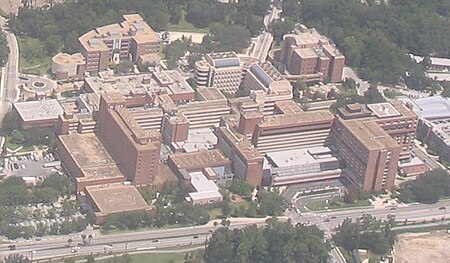Signified and signifier
|
Read other articles:

8-bit microprocessor Motorola 6809General informationLaunched1978; 46 years ago (1978)Common manufacturer(s)MotorolaPerformanceData width8Address width16Architecture and classificationInstruction set6809Number of instructions59Physical specificationsTransistors9,000Package(s)40-pin DIP The Motorola 6809 (sixty-eight-oh-nine) is an 8-bit microprocessor with some 16-bit features. It was designed by Motorola's Terry Ritter and Joel Boney and introduced in 1978. Although sourc…

1956 Pacific hurricane seasonSeason summary mapSeasonal boundariesFirst system formedMay 18, 1956Last system dissipatedOctober 18, 1956Strongest stormNameHurricane One • Maximum winds85 mph (140 km/h)(1-minute sustained) • Lowest pressure979 mbar (hPa; 28.91 inHg) Seasonal statisticsTotal storms11Hurricanes7Major hurricanes(Cat. 3+)0Total fatalities0Total damageNoneRelated articles 1956 Atlantic hurricane season 1956 Pacific typhoon season 1950s North Indian Ocean cyclone…

Deaf sign language used in the US Sandy River Valley SignNative toUnited StatesRegionSandy River Valley, MaineEra19th centuryLanguage familyMartha's Vineyard Sign Language?Language codesISO 639-3None (mis)GlottologNone Sandy River Valley Sign Language was a village sign language of the 19th-century Sandy River Valley in Maine. Together with the more famous Martha's Vineyard Sign Language and Henniker Sign Language, it was one of three local languages which formed the basis of American Sign …

Politically-charged firing Letter from President Donald Trump dismissing FBI Director James Comey Trump–Russia relations Business interactions Bayrock Group Business projects of Donald Trump in Russia Trump Tower Moscow Russian election interference 2016 US election leaks Associates' links with Russian officials and spies Cambridge Analytica Classified information disclosures Clinton emails Cyberwarfare by Russia Data seizure DCLeaks Democratic National Committee cyber attacks Democratic Natio…

乔冠华 中华人民共和国外交部部长 中国人民对外友好协会顾问 任期1974年11月—1976年12月总理周恩来 → 华国锋前任姬鹏飞继任黄华 个人资料性别男出生(1913-03-28)1913年3月28日 中華民國江蘇省盐城县逝世1983年9月22日(1983歲—09—22)(70歲) 中华人民共和国北京市籍贯江蘇鹽城国籍 中华人民共和国政党 中国共产党配偶明仁(1940年病逝) 龚澎(1970年病逝) 章含之�…

Annual ranking of countries by Legatum The Legatum Prosperity Index is an annual ranking developed by the Legatum Institute, an independent educational charity founded and part-funded by the private investment firm Legatum. The ranking is based on a variety of factors including wealth, economic growth, education, health, personal well-being, and quality of life. As of the 2021 rankings, 167 countries and territories were ranked, and Denmark topped the list, followed by its Nordic neighbours Norw…

State of being ritually impure and pure in Judaism Part of Judaic series of articles onRitual purity in Judaism Tumah and taharah Mikveh Purification methods Netilat yadayim Mikveh Red heifer Hefsek taharah Hagalah Tevilat Kelim Hierarchy Av HaTumah Midras Sources of Impurity Keri Niddah Tzaraath Zav Zavah Corpse uncleanness Tumath eretz Ha'Amim Prohibition of Kohen defilement by the dead vte This article is presented as a compilation of the laws of ṭumah and ṭaharah, as recorded in th…

American baseball player This article uses bare URLs, which are uninformative and vulnerable to link rot. Please consider converting them to full citations to ensure the article remains verifiable and maintains a consistent citation style. Several templates and tools are available to assist in formatting, such as reFill (documentation) and Citation bot (documentation). (August 2022) (Learn how and when to remove this message) Baseball player Sid FernandezPitcherBorn: (1962-10-12) October 12, 196…

This is a list of Korean inventions and discoveries; Koreans have made contributions to science and technology from ancient to modern times. In the present, South Korea plays an active role in the ongoing Digital Revolution, with one of the largest electronics industries and most innovative economies in the world.[1][2] Agriculture cheugugi A Cheugugi at Jang Yeong-sil Science Garden in Busan The first standardized rain gauge, called the cheugugi, was invented during the reign of…

Navy of the Kingdom of the Netherlands Royal Netherlands NavyKoninklijke MarineEmblem of the Royal Netherlands NavyFounded8 January 1488; 536 years ago (1488-01-08)Country Kingdom of the NetherlandsTypeNavySize7,508 active military personnel (2021)[1] 5 (1) frigates3 (1) offshore patrol vessels5 minehunters1 joint support ship1 (1) landing platform docks3 submarines40 other ships 19 helicopters: NH90 NFHPart ofNetherlands Armed ForcesHeadquartersDen Helde…

2023 Video Game 2023 video gameAssassin's Creed MirageDeveloper(s)Ubisoft Bordeaux[a]Publisher(s)UbisoftDirector(s)Stéphane BoudonProducer(s)Fabian SalomonDesigner(s)Jean-Philippe MottierProgrammer(s)Pierre Durand-SibouletArtist(s)Jean-Luc SalaWriter(s)Sarah BeaulieuComposer(s)Brendan AngelidesSeriesAssassin's CreedEngineUbisoft AnvilPlatform(s)PlayStation 4PlayStation 5WindowsXbox OneXbox Series X/SiOSiPadOSReleasePS4, PS5, Win, XBO, XSX/S5 October 2023iOS, iPadOS6 June 2024Genre(s)Act…

Australian politician Edmond AtallaMPAtalla in 2022Member of the New South Wales Parliamentfor Mount DruittIncumbentAssumed office 28 March 2015Preceded byRichard AmeryDeputy Mayor of BlacktownIn officeSeptember 2006 – September 2007MayorLeo KellyPreceded byBarbara GappsSucceeded byMichelle RowlandCouncillor of Blacktown City Councilfor Fourth WardIn office23 March 2004 – 10 September 2016 Personal detailsBorn (1960-07-17) 17 July 1960 (age 63)Port Sudan, SudanNati…

Academic college of the University of Florida College of Public Healthand Health ProfessionsTypePublic Health and Health Professions CollegeEstablished1958Parent institutionUniversity of FloridaEndowment$1.73 billion (2018)[1]DeanMichael PerriAcademic staff157Students2,505LocationGainesville, Florida, U.S.Websitewww.phhp.ufl.edu The College of Public Health and Health Profession is the school of public health and other health professions of the University of Florida. The college was esta…

Chogha Zanbilچغازنبيل (Persia)Dur Untash (Elam)Ziggurat di Chogha ZanbilLokasi di IranLokasiProvinsi Khūzestān, IranKoordinat32°0′30″N 48°31′15″E / 32.00833°N 48.52083°E / 32.00833; 48.52083SejarahPendiriUntash-NapirishaDidirikan1250 SMDitinggalkan640 SMBudayaElamCatatan situsTanggal ditemukan1951–1961ArkeologRoman GhirshmanKondisiReruntuhan Situs Warisan Dunia UNESCONama resmi: Tchogha ZanbilJenisBudayaKriteriaiii, ivDitetapkan1979 (sesi ke-3…

Church in Lima, Peru Saint Catherine of SienaIglesia y Monasterio de Santa Catalina de SienaThe church in 2010ReligionAffiliationCatholicGoverning bodyArchdiocese of LimaLocationLocationBarrios AltosArchitectureStyleBaroque, RococoCompleted1624 The Church and Monastery of Saint Catherine of Siena (Spanish: Iglesia y Monasterio de Santa Catalina de Siena) is a Catholic church and monastery located between Andahuaylas, Puno and Inambari streets in the neighbourhood of Barrios Altos, part of the hi…

American author and engineer (born 1943) Homer HickamHickam Jr. in 2020BornHomer Hadley Hickam Jr. (1943-02-19) February 19, 1943 (age 81)Coalwood, West Virginia, U.S.OccupationAuthorAlma materVirginia Tech (BS)GenreMemoirs, historical fictionNotable worksRocket Boys: A MemoirTorpedo JunctionBack to the MoonThe Josh Thurlow seriesThe Coalwood WaySky of StoneRed HelmetWe Are Not AfraidSpouseLinda Terry HickamPaula Morgan (div. 1986)RelativesHomer Hickam Sr. (father)Elsie Hickam (mother)…

Disambiguazione – Isole rimanda qui. Se stai cercando altri significati, vedi Isola (disambigua) o Isole (disambigua). Questa voce o sezione sull'argomento isole non cita le fonti necessarie o quelle presenti sono insufficienti. Puoi migliorare questa voce aggiungendo citazioni da fonti attendibili secondo le linee guida sull'uso delle fonti. Segui i suggerimenti del progetto di riferimento. Isola al largo delle Figi. Un'isola (dal latino insŭla) è una porzione di terra inte…

South Korean actor For South Korean actor of the same name born in 1984, see Lee Joon-hyuk (actor, born 1984). In this Korean name, the family name is Lee. Lee Jun-hyeokBorn (1972-03-19) March 19, 1972 (age 52)Jung District, Seoul, South KoreaOther namesLee Joon-hyukOccupationActorYears active1991–presentAgentChang CompanySpouseJi Young-anChildren3Korean nameHangul이준혁Hanja李準赫Revised RomanizationI Jun-hyeokMcCune–ReischauerYi Chun-hyŏk Lee Jun-hyeok[1] (bor…

Place in which valuables, currency, or property is kept, or the government dept. in charge of it For other uses, see Treasury (disambiguation). This article needs additional citations for verification. Please help improve this article by adding citations to reliable sources. Unsourced material may be challenged and removed.Find sources: Treasury – news · newspapers · books · scholar · JSTOR (December 2009) (Learn how and when to remove this message) The T…

Old Norse warrior fighting in a fury For other uses, see Berserker (disambiguation) and Zerker (disambiguation). Berserker / UlfheðinnArtifactSketchOne of the Vendel era Torslunda plates found on Öland, Sweden. It probably depicts one-eyed Odin guiding a berserker or ulfheðinn.[1] In the Old Norse written corpus, berserkers (Old Norse: berserkir) were those who were said to have fought in a trance-like fury, a characteristic which later gave rise to the modern English word berserk (me…

